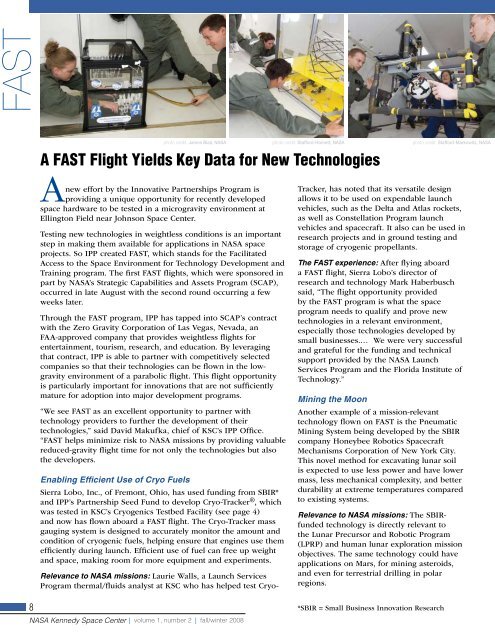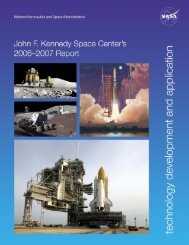Fall-Winter 2008 - Kennedy Space Center Innovative Partnerships ...
Fall-Winter 2008 - Kennedy Space Center Innovative Partnerships ...
Fall-Winter 2008 - Kennedy Space Center Innovative Partnerships ...
You also want an ePaper? Increase the reach of your titles
YUMPU automatically turns print PDFs into web optimized ePapers that Google loves.
FAst<br />
8<br />
A FAST Flight Yields Key Data for New Technologies<br />
A new effort by the <strong>Innovative</strong> <strong>Partnerships</strong> Program is<br />
providing a unique opportunity for recently developed<br />
space hardware to be tested in a microgravity environment at<br />
Ellington Field near Johnson <strong>Space</strong> <strong>Center</strong>.<br />
Testing new technologies in weightless conditions is an important<br />
step in making them available for applications in NASA space<br />
projects. So IPP created FAST, which stands for the Facilitated<br />
Access to the <strong>Space</strong> Environment for Technology Development and<br />
Training program. The first FAST flights, which were sponsored in<br />
part by NASA’s Strategic Capabilities and Assets Program (SCAP),<br />
occurred in late August with the second round occurring a few<br />
weeks later.<br />
Through the FAST program, IPP has tapped into SCAP’s contract<br />
with the Zero Gravity Corporation of Las Vegas, Nevada, an<br />
FAA-approved company that provides weightless flights for<br />
entertainment, tourism, research, and education. By leveraging<br />
that contract, IPP is able to partner with competitively selected<br />
companies so that their technologies can be flown in the lowgravity<br />
environment of a parabolic flight. This flight opportunity<br />
is particularly important for innovations that are not sufficiently<br />
mature for adoption into major development programs.<br />
“We see FAST as an excellent opportunity to partner with<br />
technology providers to further the development of their<br />
technologies,” said David Makufka, chief of KSC’s IPP Office.<br />
“FAST helps minimize risk to NASA missions by providing valuable<br />
reduced-gravity flight time for not only the technologies but also<br />
the developers.<br />
Enabling Efficient Use of Cryo Fuels<br />
Sierra Lobo, Inc., of Fremont, Ohio, has used funding from SBIR*<br />
and IPP’s Partnership Seed Fund to develop Cryo-Tracker ® , which<br />
was tested in KSC’s Cryogenics Testbed Facility (see page 4)<br />
and now has flown aboard a FAST flight. The Cryo-Tracker mass<br />
gauging system is designed to accurately monitor the amount and<br />
condition of cryogenic fuels, helping ensure that engines use them<br />
efficiently during launch. Efficient use of fuel can free up weight<br />
and space, making room for more equipment and experiments.<br />
Relevance to NASA missions: Laurie Walls, a Launch Services<br />
Program thermal/fluids analyst at KSC who has helped test Cryo-<br />
NASA <strong>Kennedy</strong> <strong>Space</strong> <strong>Center</strong> | volume 1, number 2 | fall/winter <strong>2008</strong><br />
photo credit: James Blair, NASA photo credit: Stafford-Harnett, NASA photo credit: Stafford-Markowitz, NASA<br />
Tracker, has noted that its versatile design<br />
allows it to be used on expendable launch<br />
vehicles, such as the Delta and Atlas rockets,<br />
as well as Constellation Program launch<br />
vehicles and spacecraft. It also can be used in<br />
research projects and in ground testing and<br />
storage of cryogenic propellants.<br />
The FAST experience: After flying aboard<br />
a FAST flight, Sierra Lobo’s director of<br />
research and technology Mark Haberbusch<br />
said, “The flight opportunity provided<br />
by the FAST program is what the space<br />
program needs to qualify and prove new<br />
technologies in a relevant environment,<br />
especially those technologies developed by<br />
small businesses.… We were very successful<br />
and grateful for the funding and technical<br />
support provided by the NASA Launch<br />
Services Program and the Florida Institute of<br />
Technology.”<br />
Mining the Moon<br />
Another example of a mission-relevant<br />
technology flown on FAST is the Pneumatic<br />
Mining System being developed by the SBIR<br />
company Honeybee Robotics <strong>Space</strong>craft<br />
Mechanisms Corporation of New York City.<br />
This novel method for excavating lunar soil<br />
is expected to use less power and have lower<br />
mass, less mechanical complexity, and better<br />
durability at extreme temperatures compared<br />
to existing systems.<br />
Relevance to NASA missions: The SBIRfunded<br />
technology is directly relevant to<br />
the Lunar Precursor and Robotic Program<br />
(LPRP) and human lunar exploration mission<br />
objectives. The same technology could have<br />
applications on Mars, for mining asteroids,<br />
and even for terrestrial drilling in polar<br />
regions.<br />
*SBIR = Small Business Innovation Research













